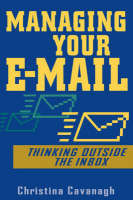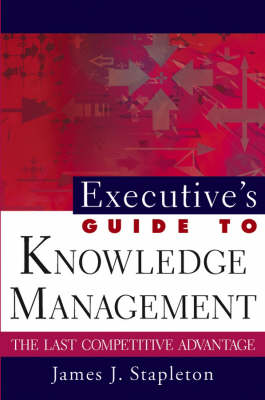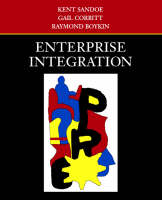Manager's Guide to Making Decisions about Information Systems
 -15%
portes grátis
-15%
portes grátis
Manager's Guide to Making Decisions about Information Systems
Paul Gray
John Wiley & Sons Inc
09/2005
352
Dura
Inglês
9780471263593
15 a 20 dias
780
Managerial Questions 1
Introduction 1
What is an Information System? 2
Components of an Information System 2
Hardware 3
Personal Computers 3
Mainframe Computers 3
Client-Server Computers 4
Remote Computing Using Application Service Providers, Web Services, and Grid Computing 4
Software 5
Operating Systems 5
Applications Programs 5
Electronic Commerce (Chapter 3) 7
ERP (Enterprise Requirements Planning) (Chapter 4) 7
Data Warehousing (Chapter 5) 8
Customer Relationship Management (Chapter 6) 8
Knowledge Management (Chapter 7) 9
Business Intelligence (Chapter 8) 10
The Internet 11
Websites 11
Connectivity 11
Finding Things Using Search Engines 12
Content Management 12
Intranet/Extranet 12
Privacy 12
Security 12
Corporate Portals 13
Website Development 13
Website Traffic Analysis 13
Answers to Managerial Questions 14
Chapter 2 the Big Picture: It and Business 15
Managerial Questions 15
Introduction 15
Strategic Advantage Versus Strategic Necessity 15
Continual Improvement 17
Introducing Strategic Information Systems 17
Risks 19
Business-it Alignment 20
Assessing the Alignment Maturity Level 21
Alignment Considerations 21
Alignment when Strategy Changes 21
Information Economics 23
The Search for Productivity 23
Why Invest? 25
Organizational Change 25
Some Practical Problems 26
Does Information Technology Matter? 26
Carr's Argument 26
The Response to Carr 27
This Book's Position 27
The Arguments for Carr 27
The Arguments against Carr's Position 28
Types of Information Systems 29
Transaction Processing Systems 29
Management Information Systems 30
Decision Support Systems 30
Knowledge-Based and Other Systems 30
Interorganizational Computing 30
Replacing Intermediation through Electronic Markets 31
Key Issues 32
Application and Technology Developments 34
Answers to Managerial Questions 35
Problems 36
Chapter 3 Electronic Commerce 37
Managerial Questions 37
Introduction 37
What is Involved in E-commerce? 39
Some E-commerce Statistics 39
Retail 40
Business to Business (B2B) 40
Technology 40
Benefits and Costs 41
Benefits 41
Costs 41
Business to Consumer (B2C) 43
Infrastructure 43
Electronic Retail Business Model 44
Information Transactions 45
Advertising 45
Impact on Retail Distribution 46
B2C in Service Industries 46
Cybermalls and Metamalls 47
Business to Business (B2B) 47
Structure of the E-marketplace 48
Electronic Data Interchange (EDI) 48
Moving to the Internet 48
Interorganizational Systems 48
Electronic Markets 50
Consumer to Consumer (C2C): The Case of Ebay 52
Consumer to Government (C2G): The Case of Wireless and 911 53
E-commerce Strategies 53
Conclusions 55
Answers to Managerial Questions 55
Problems 56
Chapter 4 Enterprise Requirements Planning 58
Managerial Questions 58
Introduction 58
How Sap Works 59
Cultural Problems of Implementation 61
ERP Vendors 62
Costs 62
Benefits 64
The Markus and Tanis View of the ERP Experience 64
Integration 65
Packages 65
Best Practices 65
Some Assembly Required 65
Reasons for Adopting or Not Adopting ERP 66
Adopting ERP 66
Not Adopting ERP 66
The ERP Team 67
The Future: ERP II 71
Final Thoughts 71
Answers to Managerial Questions 72
Problems 73
Chapter 5 Data Warehousing 74
Managerial Questions 74
Introduction 74
Definition of a Data Warehouse 75
Characteristics of a Data Warehouse 75
Subject Orientation 76
Data Integration 77
Time 78
Nonvolatile Data 78
Structure of the Data Warehouse 79
Metadata 80
Flow of Data 81
Why a Separate Warehouse? 81
Other Forms of Data Warehouses 82
Application: Online Analytic Processing 84
Application: Data Mining 86
Application: Customer Relationship Management 87
Application: Business Intelligence 88
Strategic Use 89
Managing the Data Warehouse 90
Why Warehouse Projects Can Fail 92
Data Warehousing Costs 93
The Data Warehousing Industry 94
Benefits and Problems 94
Answers to Managerial Questions 94
Problems 95
Chapter 6 Customer Relationship Management 96
Managerial Questions 96
Introduction 96
History of the CRM Market 97
The CRM Approach 99
Basic Assumptions of CRM 99
Customer 100
Relationship 100
Management 100
Drivers for CRM Applications 102
Revenue and Cost Goals 103
Principles of CRM 103
Technology and Service 104
Information Technologies for CRM 104
Key Tasks 104
IT Factors of CRM 105
Consultants 106
Return on Investment of Implementation 106
Cost and Time 106
Benefits 107
ROI of CRM Project 108
CRM Issues 109
Customer Privacy 109
Technical Immaturity 109
CRM Myths 110
The Importance of Channels 111
Vendors 111
Management Risks 112
Conclusions 115
Answers to Managerial Questions 115
Problems 115
Chapter 7 Knowledge Management 117
Managerial Questions 117
Introduction 117
Claims 118
Role of Information Technology 118
Principles of Knowledge Management 119
Knowledge Strategies 120
Leverage 120
Fragmentation, Leakage, Refreshment 120
Uncertain Value 120
Uncertainty in Value Sharing 121
Implications 121
Tacit Versus Explicit Knowledge 121
A Hierarchy of Knowledge 123
Generating Knowledge 123
Knowledge Acquisition 124
Dedicated Resources 125
Fusion 126
Adaptation 127
Networks 127
Transferring Knowledge 127
Personnel Issues 128
Km as an Industry 129
Technology 130
When Knowledge Management Makes Sense 134
Answers to Managerial Questions 135
Problems 136
Chapter 8 Business Intelligence 137
Managerial Questions 137
Introduction 137
Definition 137
Relation to other Software 138
What Can BI Do? 138
BI Technology 140
OLAP 144
Other Data Sources 147
Example: Competitive Intelligence 148
Example: Financial Analytics 150
Potential and Shortcomings 150
Return on Investment 151
Building a Business Intelligence System 152
The Business Intelligence Industry 153
Emerging Ideas in Business Intelligence 155
BI Everywhere 155
Business Process Management and Business Activity Monitoring 156
Answers to Managerial Questions 158
Problems 159
Chapter 9 Outsourcing and Its Variations: Letting Someone else Do the Work 161
Managerial Questions 161
Introduction 161
Origins of Outsourcing 162
Offshore Outsourcing 162
Outsourcing Considerations 164
A Typical Domestic Large Outsourcing Project 164
The Size of the Outsourcing Market 165
Why Outsource? 165
The Central Role of the Contract 166
Managing the Outsourcer Once the Contract Is Signed 167
Controls 169
Bottom Line on Outsourcing 170
Outsourcing the Infrastructure: Web Hosting Service Providers, Web Services, and Utility Computing 170
The Outsourcers 171
Web Hosting 171
Service Providers (xSPs) 171
Rationale 172
Should You Hire an xSP? 173
Web Services 173
Definition and Implication of Web Services 174
Running Computing as a Utility 176
Why Do It? 176
Implementing the Utility Approach 176
Stages of Utility Computing 176
Alternative Approaches 177
Risks of ASPs and Utilities 177
Answers to Managerial Issues 180
Problems 181
Chapter 10 Working Together: Systems Integration, Interorganizational Systems, Alliances, and Globalization 182
Managerial Questions 182
Introduction 182
Systems Integration 183
Definition 183
Objective 184
The Concept 184
Integrating the Enterprise 184
Integrating the Technology 185
Integration of Data, Application, and Processes 185
Aspects of Systems Integration 188
Enterprise Computing 188
Lessons Learned from Experience 189
The Systems Integration Industry 189
Management Strategy for Integration 190
Interorganizational Systems 191
Readiness 192
Control 192
Who Benefits? 194
Alliances 194
Globalization 194
Bringing in Immigrants, Moving Work Abroad 196
Privacy Rules and Transborder Data Flows 196
Answers to Managerial Questions 198
Problems 199
Chapter 11 Is in Managing Business Operations: the Supply Chain 200
Managerial Questions 200
Introduction 200
The Supply Chain 201
Software's Role 202
Why Install Supply Chain Software? 203
Cooperation 203
Manufacturing 204
Overview 204
Cad 204
Cam 205
Just-in-Time Manufacturing 205
Inventory 206
Role of ERP 207
Role of Data Warehousing 207
Challenges to Implementation 208
Other Problems Along the Supply Chain 209
Demand Forecasting 209
What Is the Payoff From Information Systems In the Supply Chain? 210
Returns 213
The Supply Chain Market 213
Major Firms in the Supply Chain Market 214
Answers to Managerial Questions 215
Problems 215
Chapter 12 The Chief Information Officer, People Issues, Project Management, Change Management 216
Managerial Questions 216
Introduction 216
Chief Information Officer 217
Managing Expectations 217
Chief Technology Officer 218
Governance and Steering Committees 219
What Is People Need to Know 219
Create Programs 220
Manage Vendors and Outsourcers 220
Customize Programs to the Firm's Needs 220
Know the Needs of the Business 220
Business Processes 220
Communicating with the User Community 221
Maintaining the Corporate Data 221
Maintaining Corporate Telecommunications 221
Integrating Systems 221
Managing E-mail and Internet Usage 222
Managing the Firm's Web Presence 222
Managing Computer Security 222
Documentation, Updates, and Training 222
Maintaining and Running the Computers 223
Help Desk 223
Role of Educational Institutions 224
Project Management 224
The Project Manager 226
Change Management 227
Conclusions 229
Answers to Managerial Questions 229
Problems 230
Chapter 13 Information Systems in Mergers and Acquisitions 231
Managerial Questions 231
Introduction 231
Why Merge? 231
Effect of Merger on Information Systems 232
Merger Principles 233
The Merger Process 233
Security Issues 234
Cultural Considerations 235
Implications of Cases 237
Answers to Managerial Questions 237
Problems 238
Chapter 14 Work Systems and Infrastructure 239
Managerial Questions 239
Introduction 239
Work System 240
Infrastructure 241
What Is Infrastructure? 241
The Infrastructure Portfolio 243
Infrastructure Architecture 244
Infrastructure Investment Strategies 244
Making Infrastructure Investment Decisions 245
Infrastructure Capabilities 246
Work Systems 246
Fundamental Concepts of Work Systems 247
Relations among the Concepts 249
Technical Considerations for IS Work System Projects 253
Answers to Managerial Questions 254
Problems 255
Chapter 15 Privacy, Security, Copyright, Patents, and other Legal And Ethical Issues 256
Managerial Questions 256
Introduction 256
Privacy 257
Privacy Statements 258
Surveillance 259
Privacy versus Convenience 261
CRM, Data Warehousing, and Other Large Databases 261
Security 261
Controls 262
New Technologies 264
The Risk of Not Investing 264
Risk Management 264
HIPAA: the Intersection of Security and Privacy 265
Announcing Security Failures 266
Disaster Recovery and Business Continuity 266
An Example 267
Who Is Responsible? 267
The Threats 267
Some IT Measures 267
Some Lessons 268
Legal Issues 268
Privacy 269
Taxation of E-commerce 269
UCITA 270
Copyright and Patents 271
Copyright 271
Patents 272
Ethics 272
Answers to Managerial Questions 274
Appendix: the Computer Industry 277
Managerial Questions 277
Definition of the Information Industry 277
U.S. Census Bureau 278
Shapiro and Varian 278
Hoover's Online 278
A Framework for Analyzing the Information Industry- The Houghton Map 279
Computer and Computer-related Segments 281
In-house Computer Shops 282
Employment 283
Outside Shops 285
Application Service Providers 285
Web Services 287
Outsourcers 287
Hardware Manufacturers 290
Retailers and Middlemen 291
Pricing and Maintenance 291
Open Source 292
Computing for Nonbusiness Applications 292
Telecommunications and Networks 292
Search Engines 293
New Technologies 293
Wi-Fi 294
RFID 294
Finding Out More About the Computer Industry and Computer Applications: the Computer Press and the Industry Observers 295
Conclusion 296
Answers to Managerial Questions 296
Glossary 299
Index 313
Managerial Questions 1
Introduction 1
What is an Information System? 2
Components of an Information System 2
Hardware 3
Personal Computers 3
Mainframe Computers 3
Client-Server Computers 4
Remote Computing Using Application Service Providers, Web Services, and Grid Computing 4
Software 5
Operating Systems 5
Applications Programs 5
Electronic Commerce (Chapter 3) 7
ERP (Enterprise Requirements Planning) (Chapter 4) 7
Data Warehousing (Chapter 5) 8
Customer Relationship Management (Chapter 6) 8
Knowledge Management (Chapter 7) 9
Business Intelligence (Chapter 8) 10
The Internet 11
Websites 11
Connectivity 11
Finding Things Using Search Engines 12
Content Management 12
Intranet/Extranet 12
Privacy 12
Security 12
Corporate Portals 13
Website Development 13
Website Traffic Analysis 13
Answers to Managerial Questions 14
Chapter 2 the Big Picture: It and Business 15
Managerial Questions 15
Introduction 15
Strategic Advantage Versus Strategic Necessity 15
Continual Improvement 17
Introducing Strategic Information Systems 17
Risks 19
Business-it Alignment 20
Assessing the Alignment Maturity Level 21
Alignment Considerations 21
Alignment when Strategy Changes 21
Information Economics 23
The Search for Productivity 23
Why Invest? 25
Organizational Change 25
Some Practical Problems 26
Does Information Technology Matter? 26
Carr's Argument 26
The Response to Carr 27
This Book's Position 27
The Arguments for Carr 27
The Arguments against Carr's Position 28
Types of Information Systems 29
Transaction Processing Systems 29
Management Information Systems 30
Decision Support Systems 30
Knowledge-Based and Other Systems 30
Interorganizational Computing 30
Replacing Intermediation through Electronic Markets 31
Key Issues 32
Application and Technology Developments 34
Answers to Managerial Questions 35
Problems 36
Chapter 3 Electronic Commerce 37
Managerial Questions 37
Introduction 37
What is Involved in E-commerce? 39
Some E-commerce Statistics 39
Retail 40
Business to Business (B2B) 40
Technology 40
Benefits and Costs 41
Benefits 41
Costs 41
Business to Consumer (B2C) 43
Infrastructure 43
Electronic Retail Business Model 44
Information Transactions 45
Advertising 45
Impact on Retail Distribution 46
B2C in Service Industries 46
Cybermalls and Metamalls 47
Business to Business (B2B) 47
Structure of the E-marketplace 48
Electronic Data Interchange (EDI) 48
Moving to the Internet 48
Interorganizational Systems 48
Electronic Markets 50
Consumer to Consumer (C2C): The Case of Ebay 52
Consumer to Government (C2G): The Case of Wireless and 911 53
E-commerce Strategies 53
Conclusions 55
Answers to Managerial Questions 55
Problems 56
Chapter 4 Enterprise Requirements Planning 58
Managerial Questions 58
Introduction 58
How Sap Works 59
Cultural Problems of Implementation 61
ERP Vendors 62
Costs 62
Benefits 64
The Markus and Tanis View of the ERP Experience 64
Integration 65
Packages 65
Best Practices 65
Some Assembly Required 65
Reasons for Adopting or Not Adopting ERP 66
Adopting ERP 66
Not Adopting ERP 66
The ERP Team 67
The Future: ERP II 71
Final Thoughts 71
Answers to Managerial Questions 72
Problems 73
Chapter 5 Data Warehousing 74
Managerial Questions 74
Introduction 74
Definition of a Data Warehouse 75
Characteristics of a Data Warehouse 75
Subject Orientation 76
Data Integration 77
Time 78
Nonvolatile Data 78
Structure of the Data Warehouse 79
Metadata 80
Flow of Data 81
Why a Separate Warehouse? 81
Other Forms of Data Warehouses 82
Application: Online Analytic Processing 84
Application: Data Mining 86
Application: Customer Relationship Management 87
Application: Business Intelligence 88
Strategic Use 89
Managing the Data Warehouse 90
Why Warehouse Projects Can Fail 92
Data Warehousing Costs 93
The Data Warehousing Industry 94
Benefits and Problems 94
Answers to Managerial Questions 94
Problems 95
Chapter 6 Customer Relationship Management 96
Managerial Questions 96
Introduction 96
History of the CRM Market 97
The CRM Approach 99
Basic Assumptions of CRM 99
Customer 100
Relationship 100
Management 100
Drivers for CRM Applications 102
Revenue and Cost Goals 103
Principles of CRM 103
Technology and Service 104
Information Technologies for CRM 104
Key Tasks 104
IT Factors of CRM 105
Consultants 106
Return on Investment of Implementation 106
Cost and Time 106
Benefits 107
ROI of CRM Project 108
CRM Issues 109
Customer Privacy 109
Technical Immaturity 109
CRM Myths 110
The Importance of Channels 111
Vendors 111
Management Risks 112
Conclusions 115
Answers to Managerial Questions 115
Problems 115
Chapter 7 Knowledge Management 117
Managerial Questions 117
Introduction 117
Claims 118
Role of Information Technology 118
Principles of Knowledge Management 119
Knowledge Strategies 120
Leverage 120
Fragmentation, Leakage, Refreshment 120
Uncertain Value 120
Uncertainty in Value Sharing 121
Implications 121
Tacit Versus Explicit Knowledge 121
A Hierarchy of Knowledge 123
Generating Knowledge 123
Knowledge Acquisition 124
Dedicated Resources 125
Fusion 126
Adaptation 127
Networks 127
Transferring Knowledge 127
Personnel Issues 128
Km as an Industry 129
Technology 130
When Knowledge Management Makes Sense 134
Answers to Managerial Questions 135
Problems 136
Chapter 8 Business Intelligence 137
Managerial Questions 137
Introduction 137
Definition 137
Relation to other Software 138
What Can BI Do? 138
BI Technology 140
OLAP 144
Other Data Sources 147
Example: Competitive Intelligence 148
Example: Financial Analytics 150
Potential and Shortcomings 150
Return on Investment 151
Building a Business Intelligence System 152
The Business Intelligence Industry 153
Emerging Ideas in Business Intelligence 155
BI Everywhere 155
Business Process Management and Business Activity Monitoring 156
Answers to Managerial Questions 158
Problems 159
Chapter 9 Outsourcing and Its Variations: Letting Someone else Do the Work 161
Managerial Questions 161
Introduction 161
Origins of Outsourcing 162
Offshore Outsourcing 162
Outsourcing Considerations 164
A Typical Domestic Large Outsourcing Project 164
The Size of the Outsourcing Market 165
Why Outsource? 165
The Central Role of the Contract 166
Managing the Outsourcer Once the Contract Is Signed 167
Controls 169
Bottom Line on Outsourcing 170
Outsourcing the Infrastructure: Web Hosting Service Providers, Web Services, and Utility Computing 170
The Outsourcers 171
Web Hosting 171
Service Providers (xSPs) 171
Rationale 172
Should You Hire an xSP? 173
Web Services 173
Definition and Implication of Web Services 174
Running Computing as a Utility 176
Why Do It? 176
Implementing the Utility Approach 176
Stages of Utility Computing 176
Alternative Approaches 177
Risks of ASPs and Utilities 177
Answers to Managerial Issues 180
Problems 181
Chapter 10 Working Together: Systems Integration, Interorganizational Systems, Alliances, and Globalization 182
Managerial Questions 182
Introduction 182
Systems Integration 183
Definition 183
Objective 184
The Concept 184
Integrating the Enterprise 184
Integrating the Technology 185
Integration of Data, Application, and Processes 185
Aspects of Systems Integration 188
Enterprise Computing 188
Lessons Learned from Experience 189
The Systems Integration Industry 189
Management Strategy for Integration 190
Interorganizational Systems 191
Readiness 192
Control 192
Who Benefits? 194
Alliances 194
Globalization 194
Bringing in Immigrants, Moving Work Abroad 196
Privacy Rules and Transborder Data Flows 196
Answers to Managerial Questions 198
Problems 199
Chapter 11 Is in Managing Business Operations: the Supply Chain 200
Managerial Questions 200
Introduction 200
The Supply Chain 201
Software's Role 202
Why Install Supply Chain Software? 203
Cooperation 203
Manufacturing 204
Overview 204
Cad 204
Cam 205
Just-in-Time Manufacturing 205
Inventory 206
Role of ERP 207
Role of Data Warehousing 207
Challenges to Implementation 208
Other Problems Along the Supply Chain 209
Demand Forecasting 209
What Is the Payoff From Information Systems In the Supply Chain? 210
Returns 213
The Supply Chain Market 213
Major Firms in the Supply Chain Market 214
Answers to Managerial Questions 215
Problems 215
Chapter 12 The Chief Information Officer, People Issues, Project Management, Change Management 216
Managerial Questions 216
Introduction 216
Chief Information Officer 217
Managing Expectations 217
Chief Technology Officer 218
Governance and Steering Committees 219
What Is People Need to Know 219
Create Programs 220
Manage Vendors and Outsourcers 220
Customize Programs to the Firm's Needs 220
Know the Needs of the Business 220
Business Processes 220
Communicating with the User Community 221
Maintaining the Corporate Data 221
Maintaining Corporate Telecommunications 221
Integrating Systems 221
Managing E-mail and Internet Usage 222
Managing the Firm's Web Presence 222
Managing Computer Security 222
Documentation, Updates, and Training 222
Maintaining and Running the Computers 223
Help Desk 223
Role of Educational Institutions 224
Project Management 224
The Project Manager 226
Change Management 227
Conclusions 229
Answers to Managerial Questions 229
Problems 230
Chapter 13 Information Systems in Mergers and Acquisitions 231
Managerial Questions 231
Introduction 231
Why Merge? 231
Effect of Merger on Information Systems 232
Merger Principles 233
The Merger Process 233
Security Issues 234
Cultural Considerations 235
Implications of Cases 237
Answers to Managerial Questions 237
Problems 238
Chapter 14 Work Systems and Infrastructure 239
Managerial Questions 239
Introduction 239
Work System 240
Infrastructure 241
What Is Infrastructure? 241
The Infrastructure Portfolio 243
Infrastructure Architecture 244
Infrastructure Investment Strategies 244
Making Infrastructure Investment Decisions 245
Infrastructure Capabilities 246
Work Systems 246
Fundamental Concepts of Work Systems 247
Relations among the Concepts 249
Technical Considerations for IS Work System Projects 253
Answers to Managerial Questions 254
Problems 255
Chapter 15 Privacy, Security, Copyright, Patents, and other Legal And Ethical Issues 256
Managerial Questions 256
Introduction 256
Privacy 257
Privacy Statements 258
Surveillance 259
Privacy versus Convenience 261
CRM, Data Warehousing, and Other Large Databases 261
Security 261
Controls 262
New Technologies 264
The Risk of Not Investing 264
Risk Management 264
HIPAA: the Intersection of Security and Privacy 265
Announcing Security Failures 266
Disaster Recovery and Business Continuity 266
An Example 267
Who Is Responsible? 267
The Threats 267
Some IT Measures 267
Some Lessons 268
Legal Issues 268
Privacy 269
Taxation of E-commerce 269
UCITA 270
Copyright and Patents 271
Copyright 271
Patents 272
Ethics 272
Answers to Managerial Questions 274
Appendix: the Computer Industry 277
Managerial Questions 277
Definition of the Information Industry 277
U.S. Census Bureau 278
Shapiro and Varian 278
Hoover's Online 278
A Framework for Analyzing the Information Industry- The Houghton Map 279
Computer and Computer-related Segments 281
In-house Computer Shops 282
Employment 283
Outside Shops 285
Application Service Providers 285
Web Services 287
Outsourcers 287
Hardware Manufacturers 290
Retailers and Middlemen 291
Pricing and Maintenance 291
Open Source 292
Computing for Nonbusiness Applications 292
Telecommunications and Networks 292
Search Engines 293
New Technologies 293
Wi-Fi 294
RFID 294
Finding Out More About the Computer Industry and Computer Applications: the Computer Press and the Industry Observers 295
Conclusion 296
Answers to Managerial Questions 296
Glossary 299
Index 313












